Infants and Toddlers Report
VerifiedAdded on 2022/09/06
|8
|1613
|17
AI Summary
Contribute Materials
Your contribution can guide someone’s learning journey. Share your
documents today.
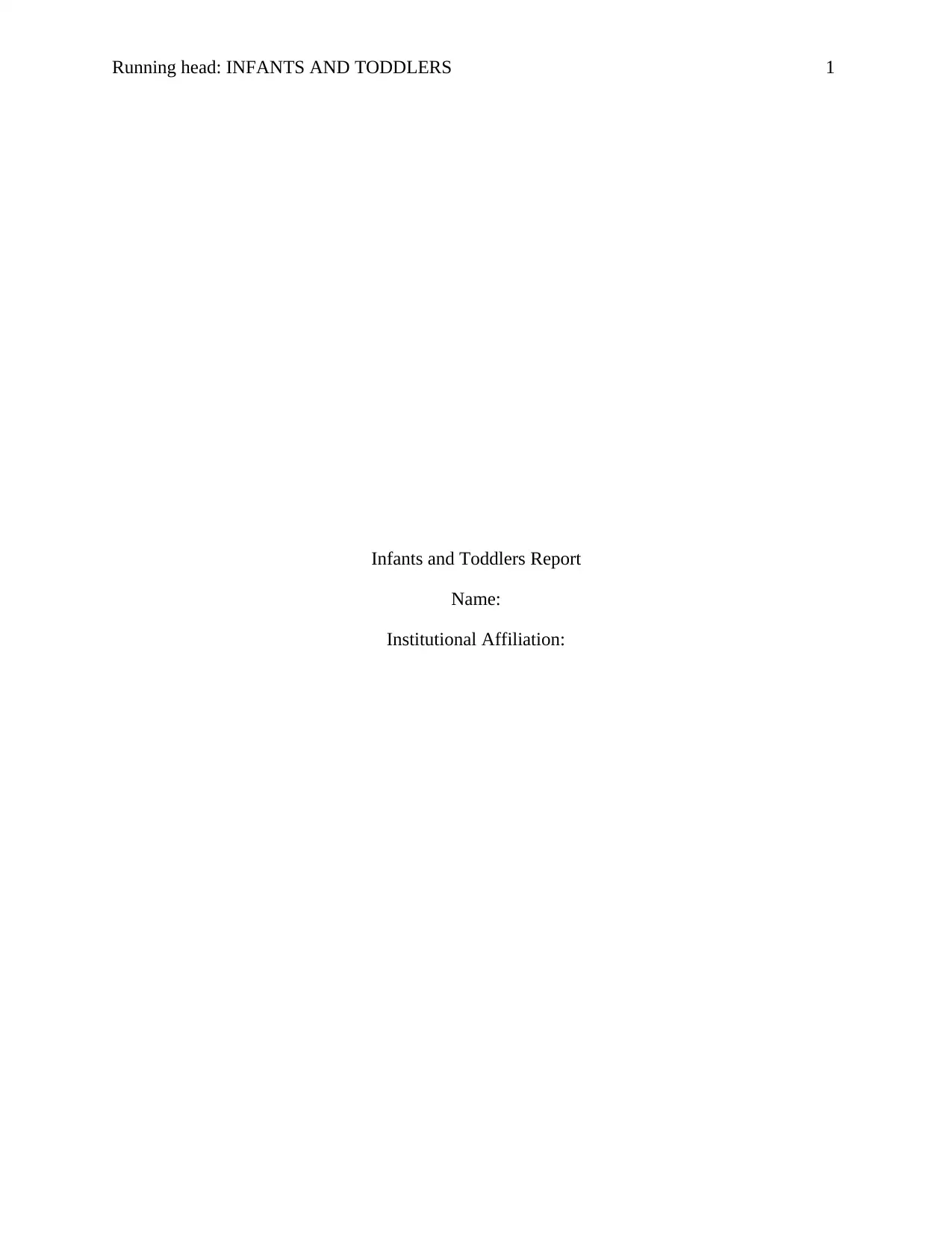
Running head: INFANTS AND TODDLERS 1
Infants and Toddlers Report
Name:
Institutional Affiliation:
Infants and Toddlers Report
Name:
Institutional Affiliation:
Secure Best Marks with AI Grader
Need help grading? Try our AI Grader for instant feedback on your assignments.
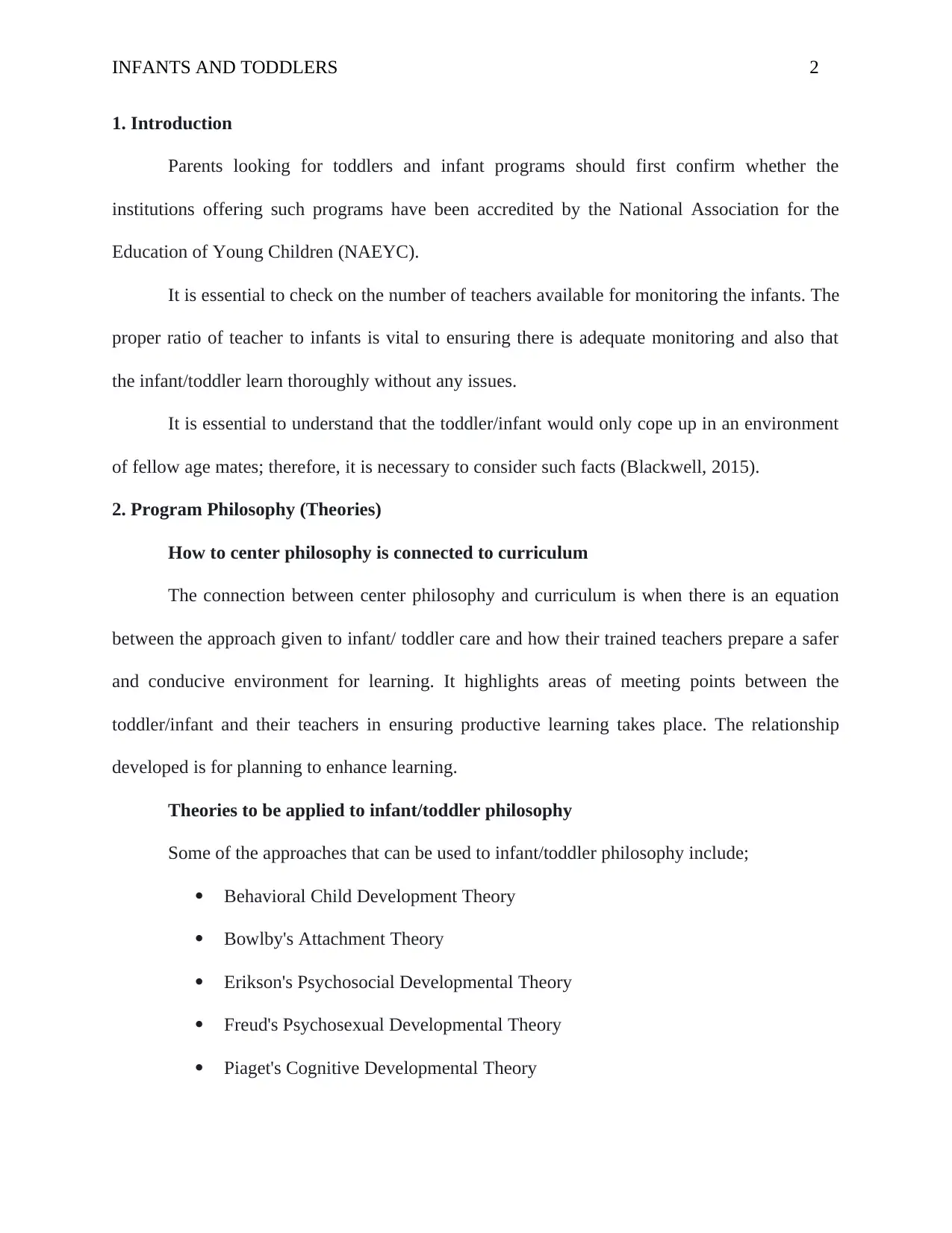
INFANTS AND TODDLERS 2
1. Introduction
Parents looking for toddlers and infant programs should first confirm whether the
institutions offering such programs have been accredited by the National Association for the
Education of Young Children (NAEYC).
It is essential to check on the number of teachers available for monitoring the infants. The
proper ratio of teacher to infants is vital to ensuring there is adequate monitoring and also that
the infant/toddler learn thoroughly without any issues.
It is essential to understand that the toddler/infant would only cope up in an environment
of fellow age mates; therefore, it is necessary to consider such facts (Blackwell, 2015).
2. Program Philosophy (Theories)
How to center philosophy is connected to curriculum
The connection between center philosophy and curriculum is when there is an equation
between the approach given to infant/ toddler care and how their trained teachers prepare a safer
and conducive environment for learning. It highlights areas of meeting points between the
toddler/infant and their teachers in ensuring productive learning takes place. The relationship
developed is for planning to enhance learning.
Theories to be applied to infant/toddler philosophy
Some of the approaches that can be used to infant/toddler philosophy include;
Behavioral Child Development Theory
Bowlby's Attachment Theory
Erikson's Psychosocial Developmental Theory
Freud's Psychosexual Developmental Theory
Piaget's Cognitive Developmental Theory
1. Introduction
Parents looking for toddlers and infant programs should first confirm whether the
institutions offering such programs have been accredited by the National Association for the
Education of Young Children (NAEYC).
It is essential to check on the number of teachers available for monitoring the infants. The
proper ratio of teacher to infants is vital to ensuring there is adequate monitoring and also that
the infant/toddler learn thoroughly without any issues.
It is essential to understand that the toddler/infant would only cope up in an environment
of fellow age mates; therefore, it is necessary to consider such facts (Blackwell, 2015).
2. Program Philosophy (Theories)
How to center philosophy is connected to curriculum
The connection between center philosophy and curriculum is when there is an equation
between the approach given to infant/ toddler care and how their trained teachers prepare a safer
and conducive environment for learning. It highlights areas of meeting points between the
toddler/infant and their teachers in ensuring productive learning takes place. The relationship
developed is for planning to enhance learning.
Theories to be applied to infant/toddler philosophy
Some of the approaches that can be used to infant/toddler philosophy include;
Behavioral Child Development Theory
Bowlby's Attachment Theory
Erikson's Psychosocial Developmental Theory
Freud's Psychosexual Developmental Theory
Piaget's Cognitive Developmental Theory
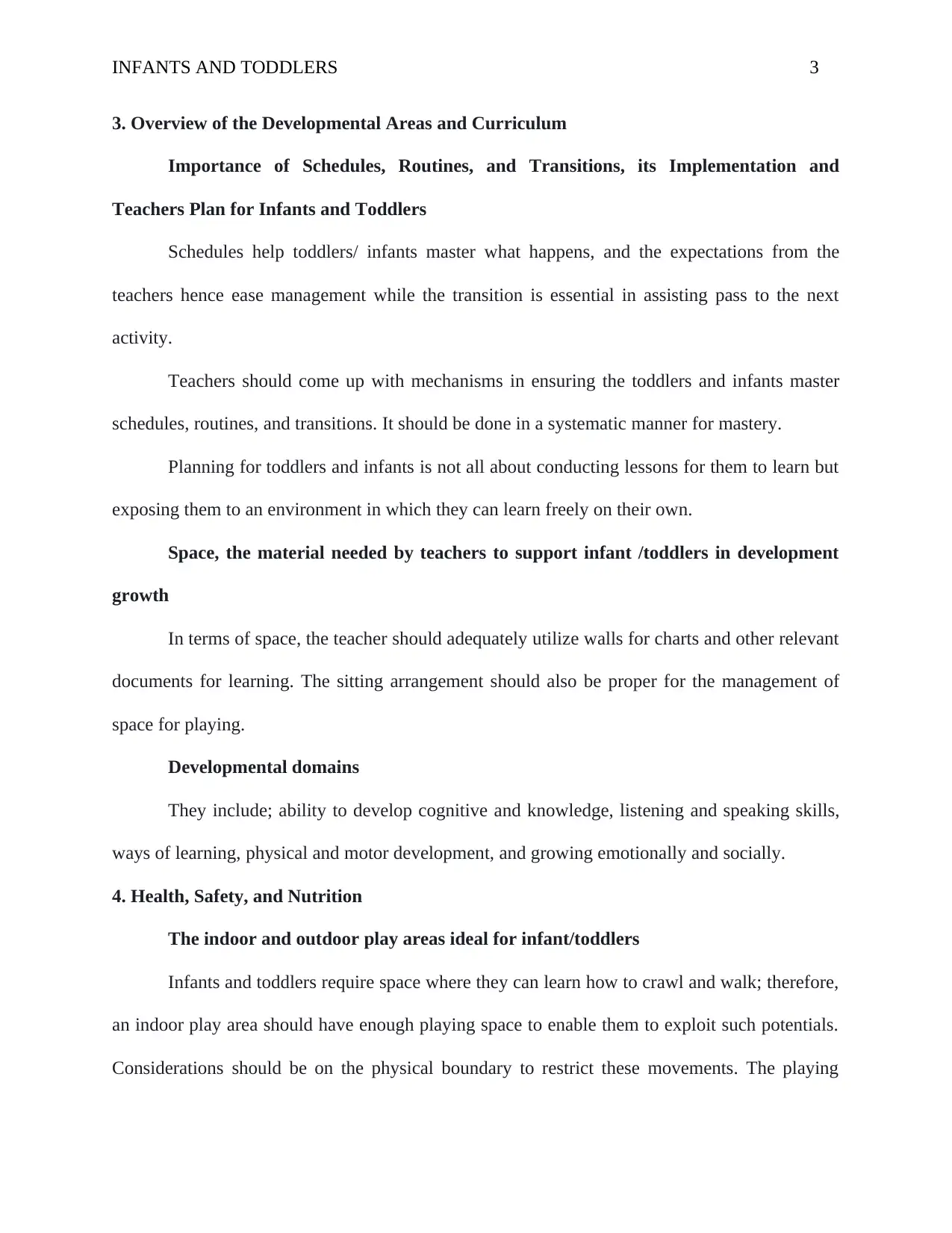
INFANTS AND TODDLERS 3
3. Overview of the Developmental Areas and Curriculum
Importance of Schedules, Routines, and Transitions, its Implementation and
Teachers Plan for Infants and Toddlers
Schedules help toddlers/ infants master what happens, and the expectations from the
teachers hence ease management while the transition is essential in assisting pass to the next
activity.
Teachers should come up with mechanisms in ensuring the toddlers and infants master
schedules, routines, and transitions. It should be done in a systematic manner for mastery.
Planning for toddlers and infants is not all about conducting lessons for them to learn but
exposing them to an environment in which they can learn freely on their own.
Space, the material needed by teachers to support infant /toddlers in development
growth
In terms of space, the teacher should adequately utilize walls for charts and other relevant
documents for learning. The sitting arrangement should also be proper for the management of
space for playing.
Developmental domains
They include; ability to develop cognitive and knowledge, listening and speaking skills,
ways of learning, physical and motor development, and growing emotionally and socially.
4. Health, Safety, and Nutrition
The indoor and outdoor play areas ideal for infant/toddlers
Infants and toddlers require space where they can learn how to crawl and walk; therefore,
an indoor play area should have enough playing space to enable them to exploit such potentials.
Considerations should be on the physical boundary to restrict these movements. The playing
3. Overview of the Developmental Areas and Curriculum
Importance of Schedules, Routines, and Transitions, its Implementation and
Teachers Plan for Infants and Toddlers
Schedules help toddlers/ infants master what happens, and the expectations from the
teachers hence ease management while the transition is essential in assisting pass to the next
activity.
Teachers should come up with mechanisms in ensuring the toddlers and infants master
schedules, routines, and transitions. It should be done in a systematic manner for mastery.
Planning for toddlers and infants is not all about conducting lessons for them to learn but
exposing them to an environment in which they can learn freely on their own.
Space, the material needed by teachers to support infant /toddlers in development
growth
In terms of space, the teacher should adequately utilize walls for charts and other relevant
documents for learning. The sitting arrangement should also be proper for the management of
space for playing.
Developmental domains
They include; ability to develop cognitive and knowledge, listening and speaking skills,
ways of learning, physical and motor development, and growing emotionally and socially.
4. Health, Safety, and Nutrition
The indoor and outdoor play areas ideal for infant/toddlers
Infants and toddlers require space where they can learn how to crawl and walk; therefore,
an indoor play area should have enough playing space to enable them to exploit such potentials.
Considerations should be on the physical boundary to restrict these movements. The playing
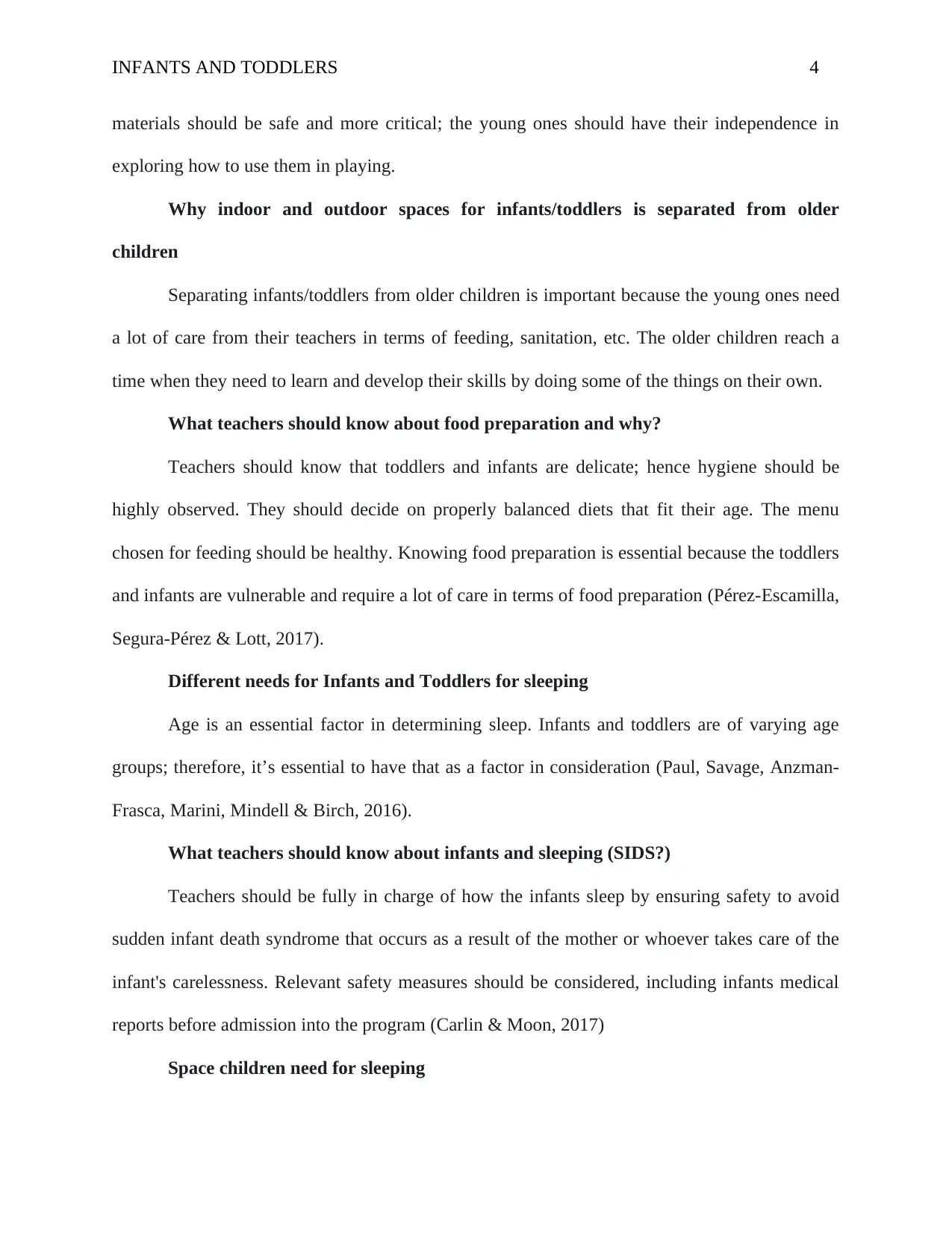
INFANTS AND TODDLERS 4
materials should be safe and more critical; the young ones should have their independence in
exploring how to use them in playing.
Why indoor and outdoor spaces for infants/toddlers is separated from older
children
Separating infants/toddlers from older children is important because the young ones need
a lot of care from their teachers in terms of feeding, sanitation, etc. The older children reach a
time when they need to learn and develop their skills by doing some of the things on their own.
What teachers should know about food preparation and why?
Teachers should know that toddlers and infants are delicate; hence hygiene should be
highly observed. They should decide on properly balanced diets that fit their age. The menu
chosen for feeding should be healthy. Knowing food preparation is essential because the toddlers
and infants are vulnerable and require a lot of care in terms of food preparation (Pérez-Escamilla,
Segura-Pérez & Lott, 2017).
Different needs for Infants and Toddlers for sleeping
Age is an essential factor in determining sleep. Infants and toddlers are of varying age
groups; therefore, it’s essential to have that as a factor in consideration (Paul, Savage, Anzman-
Frasca, Marini, Mindell & Birch, 2016).
What teachers should know about infants and sleeping (SIDS?)
Teachers should be fully in charge of how the infants sleep by ensuring safety to avoid
sudden infant death syndrome that occurs as a result of the mother or whoever takes care of the
infant's carelessness. Relevant safety measures should be considered, including infants medical
reports before admission into the program (Carlin & Moon, 2017)
Space children need for sleeping
materials should be safe and more critical; the young ones should have their independence in
exploring how to use them in playing.
Why indoor and outdoor spaces for infants/toddlers is separated from older
children
Separating infants/toddlers from older children is important because the young ones need
a lot of care from their teachers in terms of feeding, sanitation, etc. The older children reach a
time when they need to learn and develop their skills by doing some of the things on their own.
What teachers should know about food preparation and why?
Teachers should know that toddlers and infants are delicate; hence hygiene should be
highly observed. They should decide on properly balanced diets that fit their age. The menu
chosen for feeding should be healthy. Knowing food preparation is essential because the toddlers
and infants are vulnerable and require a lot of care in terms of food preparation (Pérez-Escamilla,
Segura-Pérez & Lott, 2017).
Different needs for Infants and Toddlers for sleeping
Age is an essential factor in determining sleep. Infants and toddlers are of varying age
groups; therefore, it’s essential to have that as a factor in consideration (Paul, Savage, Anzman-
Frasca, Marini, Mindell & Birch, 2016).
What teachers should know about infants and sleeping (SIDS?)
Teachers should be fully in charge of how the infants sleep by ensuring safety to avoid
sudden infant death syndrome that occurs as a result of the mother or whoever takes care of the
infant's carelessness. Relevant safety measures should be considered, including infants medical
reports before admission into the program (Carlin & Moon, 2017)
Space children need for sleeping
Secure Best Marks with AI Grader
Need help grading? Try our AI Grader for instant feedback on your assignments.
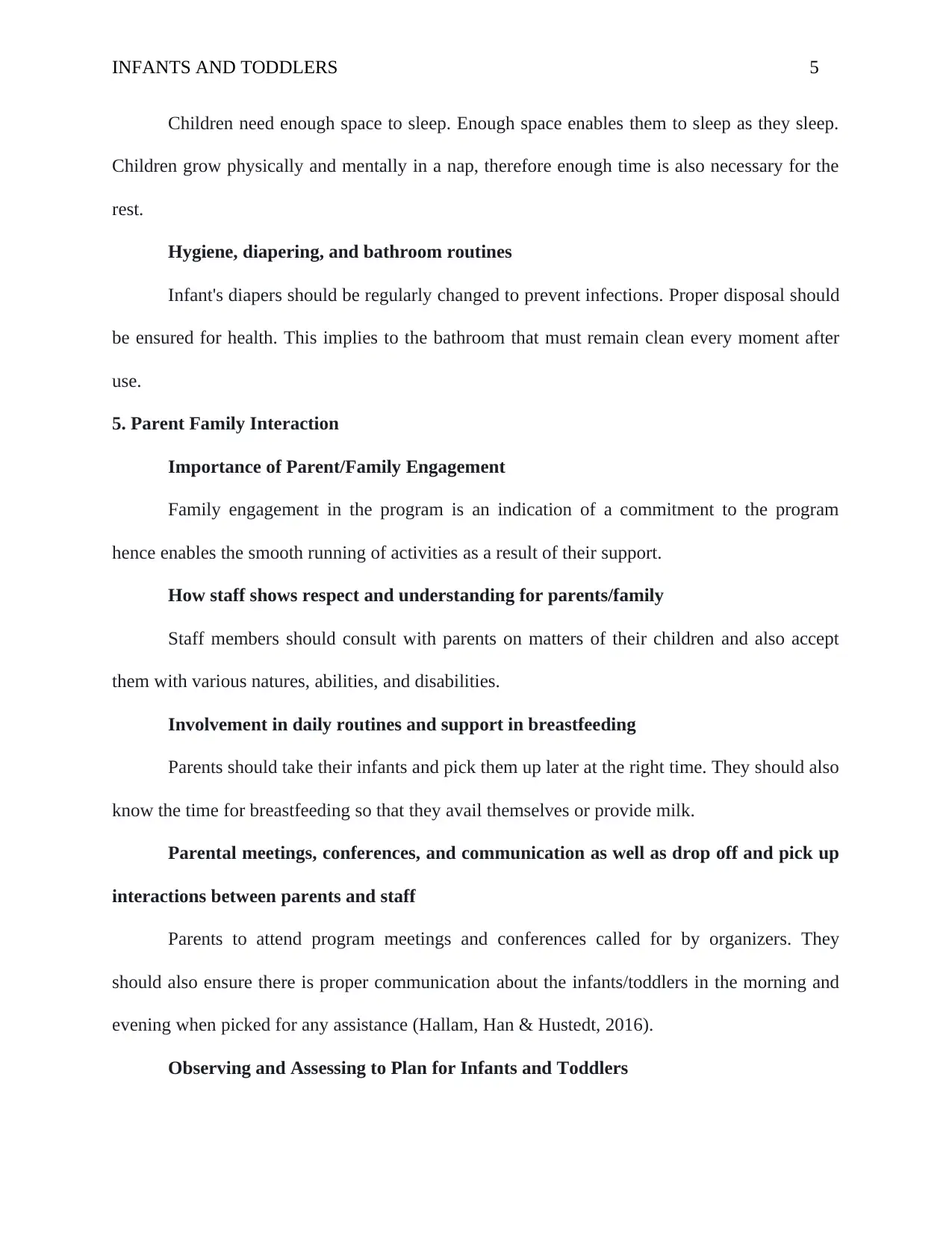
INFANTS AND TODDLERS 5
Children need enough space to sleep. Enough space enables them to sleep as they sleep.
Children grow physically and mentally in a nap, therefore enough time is also necessary for the
rest.
Hygiene, diapering, and bathroom routines
Infant's diapers should be regularly changed to prevent infections. Proper disposal should
be ensured for health. This implies to the bathroom that must remain clean every moment after
use.
5. Parent Family Interaction
Importance of Parent/Family Engagement
Family engagement in the program is an indication of a commitment to the program
hence enables the smooth running of activities as a result of their support.
How staff shows respect and understanding for parents/family
Staff members should consult with parents on matters of their children and also accept
them with various natures, abilities, and disabilities.
Involvement in daily routines and support in breastfeeding
Parents should take their infants and pick them up later at the right time. They should also
know the time for breastfeeding so that they avail themselves or provide milk.
Parental meetings, conferences, and communication as well as drop off and pick up
interactions between parents and staff
Parents to attend program meetings and conferences called for by organizers. They
should also ensure there is proper communication about the infants/toddlers in the morning and
evening when picked for any assistance (Hallam, Han & Hustedt, 2016).
Observing and Assessing to Plan for Infants and Toddlers
Children need enough space to sleep. Enough space enables them to sleep as they sleep.
Children grow physically and mentally in a nap, therefore enough time is also necessary for the
rest.
Hygiene, diapering, and bathroom routines
Infant's diapers should be regularly changed to prevent infections. Proper disposal should
be ensured for health. This implies to the bathroom that must remain clean every moment after
use.
5. Parent Family Interaction
Importance of Parent/Family Engagement
Family engagement in the program is an indication of a commitment to the program
hence enables the smooth running of activities as a result of their support.
How staff shows respect and understanding for parents/family
Staff members should consult with parents on matters of their children and also accept
them with various natures, abilities, and disabilities.
Involvement in daily routines and support in breastfeeding
Parents should take their infants and pick them up later at the right time. They should also
know the time for breastfeeding so that they avail themselves or provide milk.
Parental meetings, conferences, and communication as well as drop off and pick up
interactions between parents and staff
Parents to attend program meetings and conferences called for by organizers. They
should also ensure there is proper communication about the infants/toddlers in the morning and
evening when picked for any assistance (Hallam, Han & Hustedt, 2016).
Observing and Assessing to Plan for Infants and Toddlers
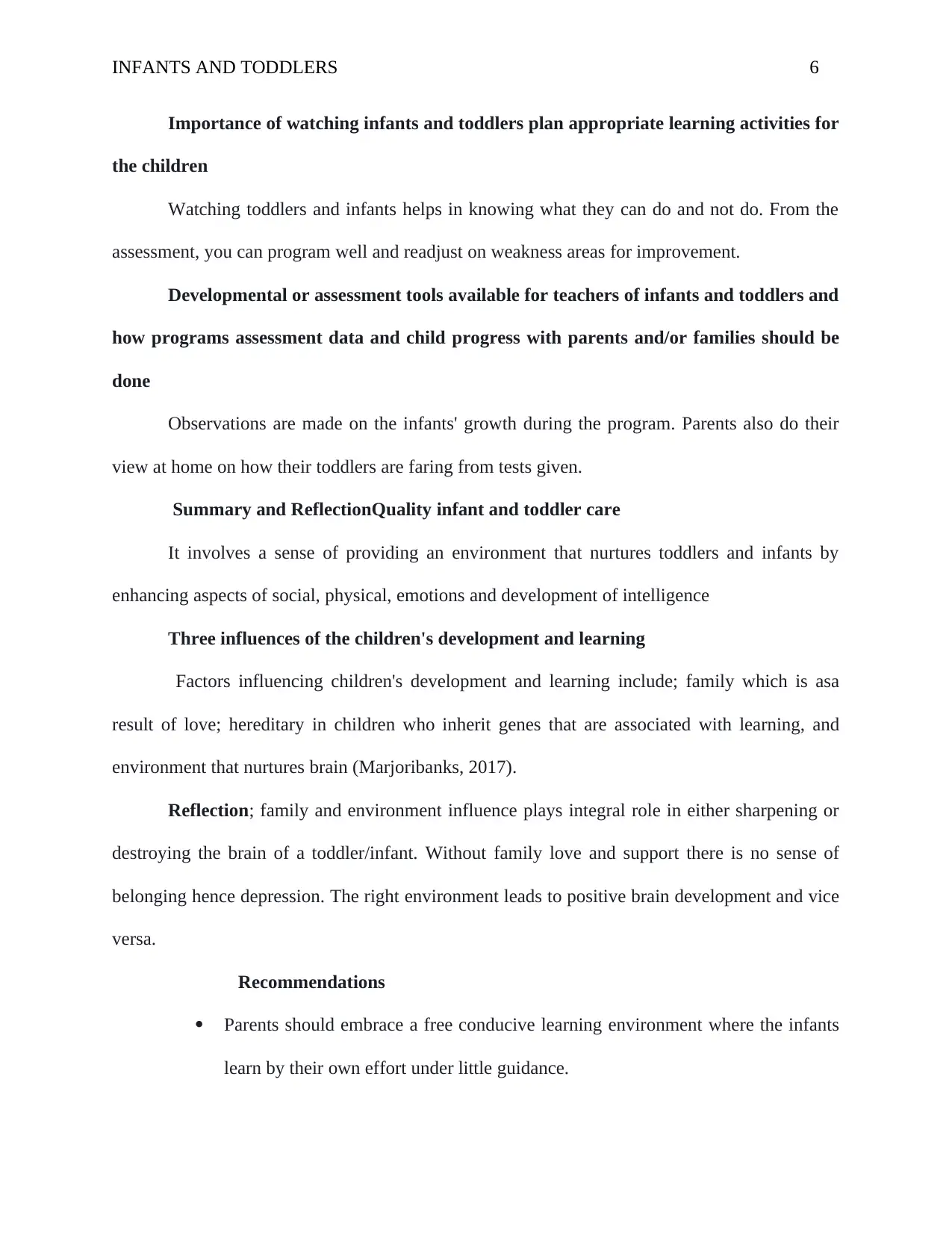
INFANTS AND TODDLERS 6
Importance of watching infants and toddlers plan appropriate learning activities for
the children
Watching toddlers and infants helps in knowing what they can do and not do. From the
assessment, you can program well and readjust on weakness areas for improvement.
Developmental or assessment tools available for teachers of infants and toddlers and
how programs assessment data and child progress with parents and/or families should be
done
Observations are made on the infants' growth during the program. Parents also do their
view at home on how their toddlers are faring from tests given.
Summary and ReflectionQuality infant and toddler care
It involves a sense of providing an environment that nurtures toddlers and infants by
enhancing aspects of social, physical, emotions and development of intelligence
Three influences of the children's development and learning
Factors influencing children's development and learning include; family which is asa
result of love; hereditary in children who inherit genes that are associated with learning, and
environment that nurtures brain (Marjoribanks, 2017).
Reflection; family and environment influence plays integral role in either sharpening or
destroying the brain of a toddler/infant. Without family love and support there is no sense of
belonging hence depression. The right environment leads to positive brain development and vice
versa.
Recommendations
Parents should embrace a free conducive learning environment where the infants
learn by their own effort under little guidance.
Importance of watching infants and toddlers plan appropriate learning activities for
the children
Watching toddlers and infants helps in knowing what they can do and not do. From the
assessment, you can program well and readjust on weakness areas for improvement.
Developmental or assessment tools available for teachers of infants and toddlers and
how programs assessment data and child progress with parents and/or families should be
done
Observations are made on the infants' growth during the program. Parents also do their
view at home on how their toddlers are faring from tests given.
Summary and ReflectionQuality infant and toddler care
It involves a sense of providing an environment that nurtures toddlers and infants by
enhancing aspects of social, physical, emotions and development of intelligence
Three influences of the children's development and learning
Factors influencing children's development and learning include; family which is asa
result of love; hereditary in children who inherit genes that are associated with learning, and
environment that nurtures brain (Marjoribanks, 2017).
Reflection; family and environment influence plays integral role in either sharpening or
destroying the brain of a toddler/infant. Without family love and support there is no sense of
belonging hence depression. The right environment leads to positive brain development and vice
versa.
Recommendations
Parents should embrace a free conducive learning environment where the infants
learn by their own effort under little guidance.
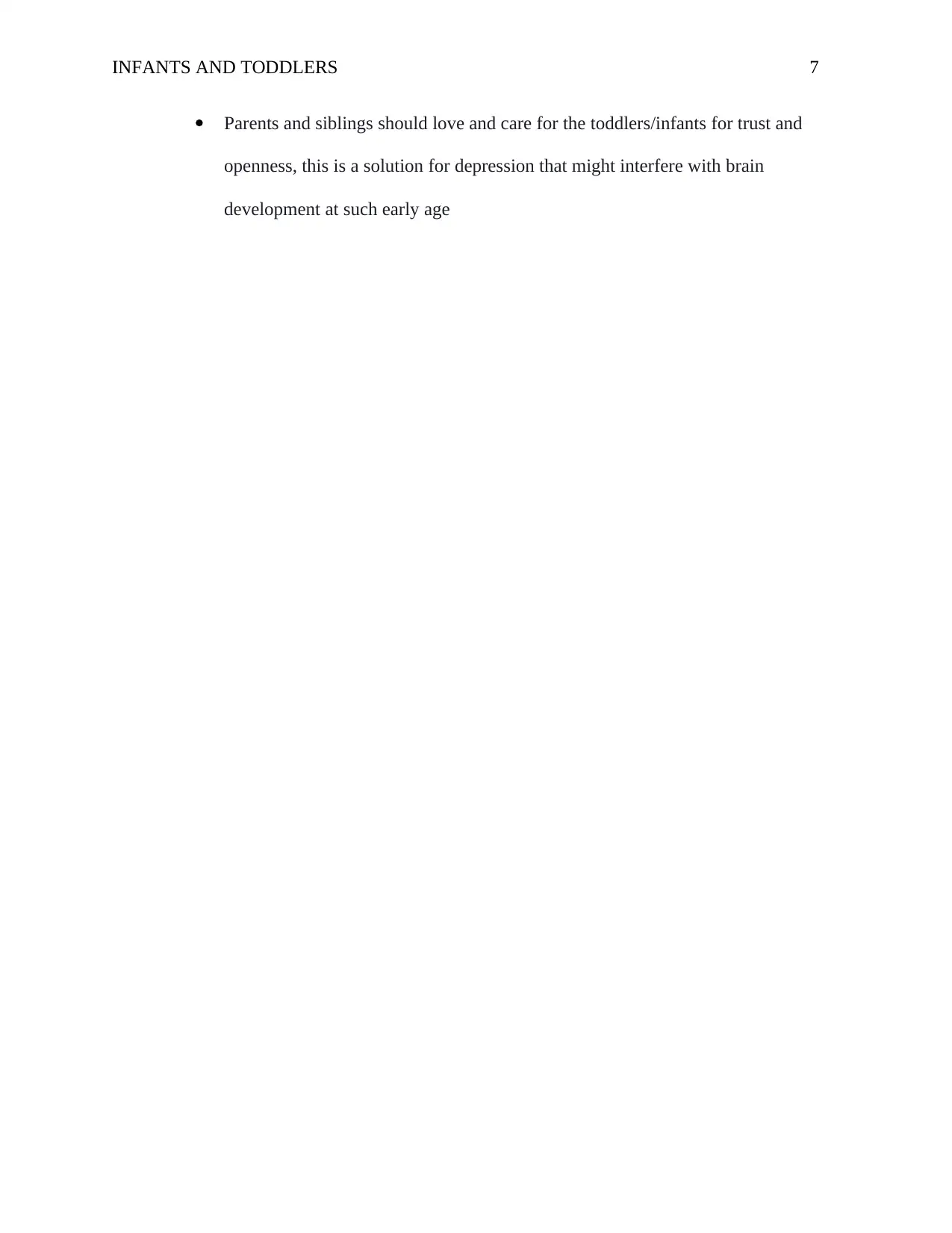
INFANTS AND TODDLERS 7
Parents and siblings should love and care for the toddlers/infants for trust and
openness, this is a solution for depression that might interfere with brain
development at such early age
Parents and siblings should love and care for the toddlers/infants for trust and
openness, this is a solution for depression that might interfere with brain
development at such early age
Paraphrase This Document
Need a fresh take? Get an instant paraphrase of this document with our AI Paraphraser
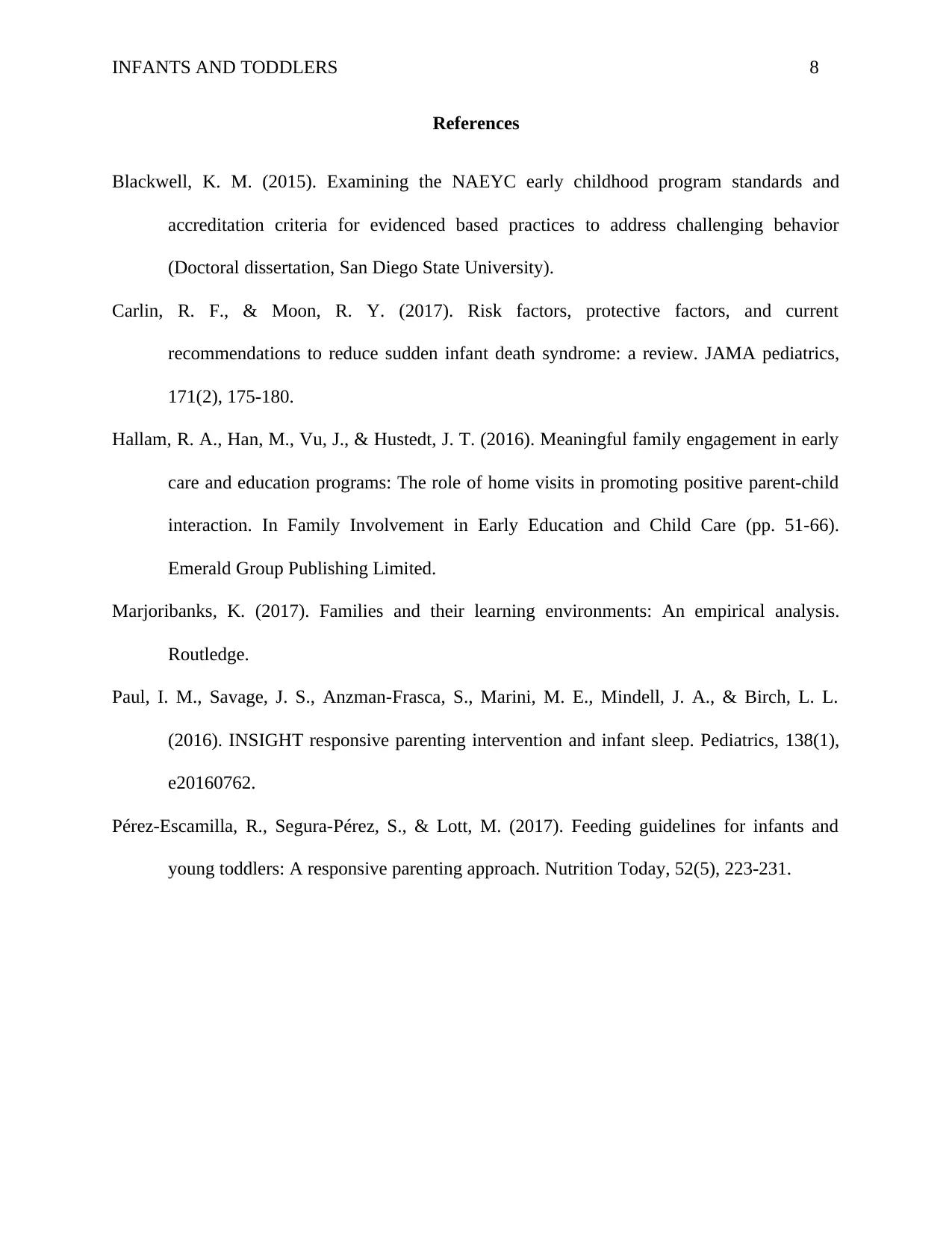
INFANTS AND TODDLERS 8
References
Blackwell, K. M. (2015). Examining the NAEYC early childhood program standards and
accreditation criteria for evidenced based practices to address challenging behavior
(Doctoral dissertation, San Diego State University).
Carlin, R. F., & Moon, R. Y. (2017). Risk factors, protective factors, and current
recommendations to reduce sudden infant death syndrome: a review. JAMA pediatrics,
171(2), 175-180.
Hallam, R. A., Han, M., Vu, J., & Hustedt, J. T. (2016). Meaningful family engagement in early
care and education programs: The role of home visits in promoting positive parent-child
interaction. In Family Involvement in Early Education and Child Care (pp. 51-66).
Emerald Group Publishing Limited.
Marjoribanks, K. (2017). Families and their learning environments: An empirical analysis.
Routledge.
Paul, I. M., Savage, J. S., Anzman-Frasca, S., Marini, M. E., Mindell, J. A., & Birch, L. L.
(2016). INSIGHT responsive parenting intervention and infant sleep. Pediatrics, 138(1),
e20160762.
Pérez-Escamilla, R., Segura-Pérez, S., & Lott, M. (2017). Feeding guidelines for infants and
young toddlers: A responsive parenting approach. Nutrition Today, 52(5), 223-231.
References
Blackwell, K. M. (2015). Examining the NAEYC early childhood program standards and
accreditation criteria for evidenced based practices to address challenging behavior
(Doctoral dissertation, San Diego State University).
Carlin, R. F., & Moon, R. Y. (2017). Risk factors, protective factors, and current
recommendations to reduce sudden infant death syndrome: a review. JAMA pediatrics,
171(2), 175-180.
Hallam, R. A., Han, M., Vu, J., & Hustedt, J. T. (2016). Meaningful family engagement in early
care and education programs: The role of home visits in promoting positive parent-child
interaction. In Family Involvement in Early Education and Child Care (pp. 51-66).
Emerald Group Publishing Limited.
Marjoribanks, K. (2017). Families and their learning environments: An empirical analysis.
Routledge.
Paul, I. M., Savage, J. S., Anzman-Frasca, S., Marini, M. E., Mindell, J. A., & Birch, L. L.
(2016). INSIGHT responsive parenting intervention and infant sleep. Pediatrics, 138(1),
e20160762.
Pérez-Escamilla, R., Segura-Pérez, S., & Lott, M. (2017). Feeding guidelines for infants and
young toddlers: A responsive parenting approach. Nutrition Today, 52(5), 223-231.
1 out of 8
Related Documents
Your All-in-One AI-Powered Toolkit for Academic Success.
+13062052269
info@desklib.com
Available 24*7 on WhatsApp / Email
![[object Object]](/_next/static/media/star-bottom.7253800d.svg)
Unlock your academic potential
© 2024 | Zucol Services PVT LTD | All rights reserved.





